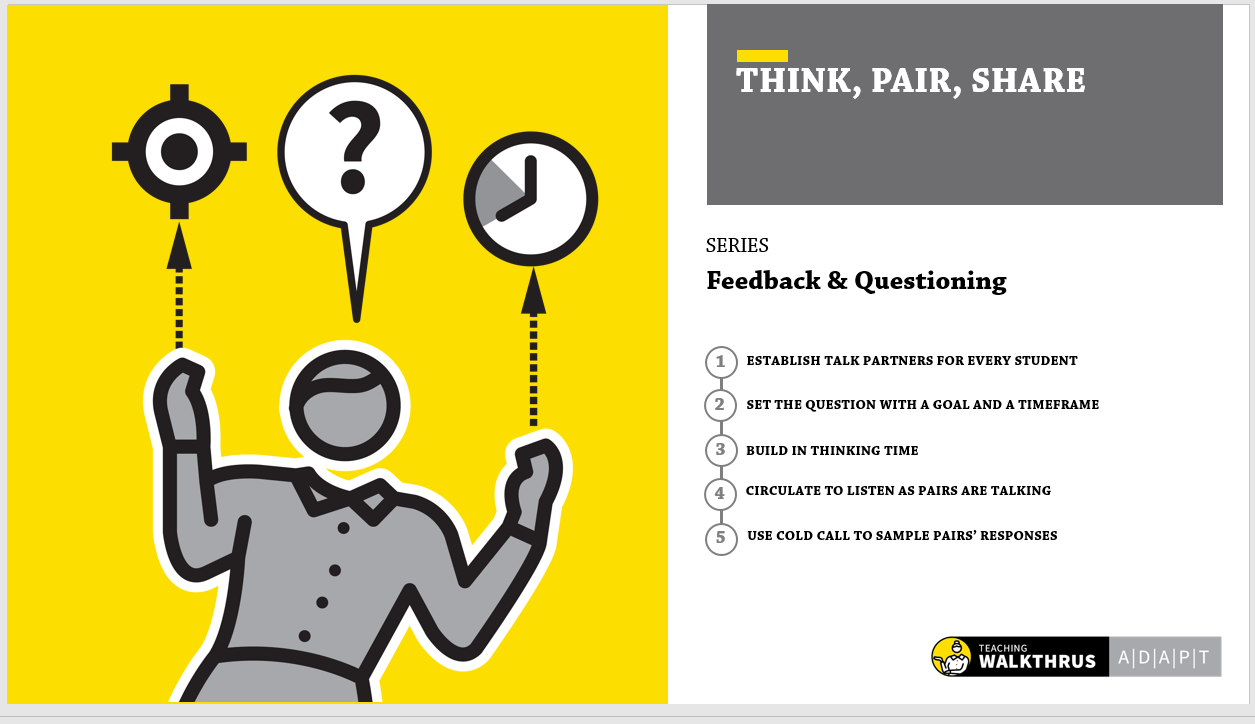12 November 2021

|
Whole School CPD Focus: |
Feedback and Questioning |
|
Walkthru Cluster: |
Feedback and Questioning |
|
Walkthru: |
‘Think-Pair-Share’ (page 92) plus the Teacher Workbook |
|
Starting Point |
|
|
Reflections…
Think-Pair-Share. Where some Kagan strategies fade in and out of focus, Think-Pair-Share stands front and centre of the fully inclusive and academically challenging classroom. Working in pairs is probably the simplest learning dialogue to organise, as students simply discuss with a partner. This is a way for students to validate their thoughts and a way of ensuring that all are involved and participating. As is the case with many of Sherrington’s Walkthrus, Think-Pair-Share works well when used in conjunction with Signal, Pause, Insist as teachers can switch from whole-class listening and back to paired discussion. This also affords the teacher the invaluable opportunity to listen to discussion and to then pick up misconceptions in class discussion.
As this collaborative strategy has been part of classroom practice for a number of years, the various stages have been altered and adapted along the way. Sherrington’s five point implementation plan relies on these fundamental stages:
Stage One: Establish Talk Partners for Every Student. Sherrington suggests that it is important to pre-determine talk partners. By establishing this routine, it will reduce wasted time and makes the co-operative learning process purposeful and – hopefully – impactful. Ideally, Sherrington suggests, talk partners need to be well-matched so that one person does not dominate the discussion. All stakeholders need to have an equal opportunity to learn
Stage Two: Set the Question with a Goal and a Timeframe. This stage bears resemblance to elements of Cold-Calling in that a question is set and then students should discuss it in pairs. Teachers may wish to lead a free discussion to generate ideas but Sherrington, quite rightly, highlights the significance of setting a precise goal: e.g. ‘list five key features of the character’ or ‘explain the process in four or five bullet points.’ It is also important, within this stage, to set a precise timeframe. This will help maximise use of time and will also ensure focus and energy of discussion.
Stage Three: Build in Thinking Time. Many advocates of Think-Pair-Share think of this stage as optional. However, by building in thinking time, you are ensuring that all students buy-in to the learning. The disadvantage of this stage is that it takes more time. Coming to a decision on whether to use or ditch this stage will depend on whether the opportunity cost of ensuring optimum buy-in outweighs the time lost from allowing it.
Stage Four: Circulate to Listen as Pairs are Talking. From experience as a teacher and also as an observer, this is the stage that is often neglected. This stage relies on the teacher listening to responses and then adapting their lesson to the needs highlighted from these discussions. It works to support our FEEDBACK-PLAN-TEACH methodology. The feedback gleaned here allows teachers to discern misconceptions, interesting ideas or subtle technicalities. Clearly, this stage will truly come into its own with more detailed and in-depth questions.
Stage Five: Use Cold Call to Sample Pairs’ Responses. Sherrington suggests that using Signal-Pause-Insist here brings the class back to attention. He then goes on to suggest using Cold-Calling to sample discussions. At this point, students are often asked to relay their own answers; however, it is often more effective to cue in all learners by inviting pairs, using individual names, to feedback or by asking individuals to relay their partner’s answer: ‘Michael, what were you and Annie discussing in your pair?’ or ‘Michael, please could you tell us what Annie thought? Did you agree with her?’
By using these stages, many will simply be tweaking an already-used approach; however, by really implementing these stages as Sherrington suggests will ensure that learning is engaging and challenging.
|
|
|
CPD Cascade |
RLO – Cold-Calling Reflections https://classteaching.wordpress.com/2021/10/21/reflections-on-cold-calling/
RHO – Sherrington’s Checking for Understanding 7 Principles of Effective Feedback (RHO)from Teacher Toolkit
https://www.youtube.com/watch?v=v3UazBMmwVA
Mini-whiteboard tips (RHO)https://www.johntomsett.com/2021/10/17/this-much-i-know-about-how-to-get-better-at-using-mini-whiteboards-in-your-classroom/Sexual Harassment and Gender StereotypingFree online training to tackle sexual harassment, language and gender stereotyping. https://training.ukfeminista.org.uk/
National CollegeRemember that there are subject-specific watchlists available in National College.
Useful Webinars from Creative Education (RSW)
Title: Tics and Tic Disorders: Recognising & Supporting Date: 15th of November at 4 pm UK time How to book: Register here to attend
Date: 16th of November at 4 pm UK time How to book: Register here to attend
Title: Whatever you are passionate about, it needs to include Postural Care too Date: 10th of November at 4 pm UK time How to book: Register here to attend
Title: Developing & Implementing a Relational Approach to Behaviour Date: 9th of November at 4 pm UK time How to book: Register here to attend
Using Personal Growth Plans as a Springboard for Staff Development New to the Role of Mental Health Lead |
Posted by Rachel Long
Category: Teaching and Learning Digests
